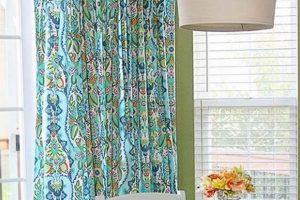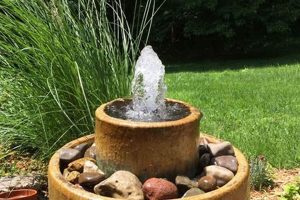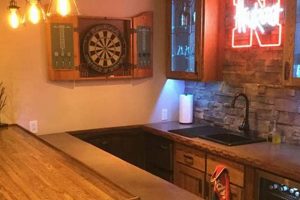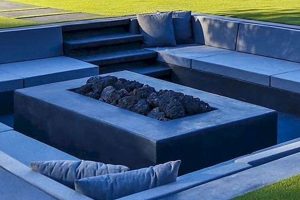Constructing a protective structure for a children’s play area filled with sand involves various creative solutions, often utilizing readily available materials and basic construction techniques. These solutions aim to shield the sand from environmental elements, animal intrusion, and debris, thereby maintaining its cleanliness and suitability for play. Examples include hinged wooden covers, tarpaulin systems secured with bungee cords, and repurposed pallet structures designed for ease of use and durability.
Implementing protective measures for a sand-filled play space offers several advantages. It significantly reduces the need for frequent sand replacement due to contamination from rain, leaves, and animal waste. This protective approach also extends the lifespan of the play area and minimizes potential health risks associated with unsanitary conditions. Historically, rudimentary covers, such as simple cloth drapes, were employed to safeguard sand pits; modern approaches incorporate improved materials and design for increased effectiveness.
The subsequent sections detail a variety of construction approaches, material selections, and design considerations to guide individuals in creating effective protection for their outdoor sand play areas. Emphasis is placed on cost-effectiveness, ease of assembly, and the suitability of each approach to varying sandbox dimensions and environmental conditions.
Practical Guidelines for Constructing Sandbox Protection
The following points offer guidance in the design and implementation of a protective structure for sand-filled play areas. Careful consideration of these elements will contribute to the effectiveness and longevity of the solution.
Tip 1: Material Selection: Opt for durable, weather-resistant materials such as treated lumber, exterior-grade plywood, or heavy-duty tarpaulins. These materials provide protection against moisture, sunlight, and physical damage, extending the lifespan of the structure.
Tip 2: Secure Fastening Mechanisms: Employ robust hinges, latches, or bungee cords to ensure the protective structure remains securely in place, particularly during inclement weather. Regularly inspect and maintain these mechanisms to prevent failure.
Tip 3: Drainage Considerations: Incorporate a slight slope or drainage holes in the cover design to prevent water accumulation. Stagnant water can lead to mold growth and compromise the integrity of the materials.
Tip 4: Safety Features: Implement safety features such as rounded edges, smooth surfaces, and secure locking mechanisms to minimize the risk of injury, especially for young children. Avoid using sharp or protruding hardware.
Tip 5: Size and Coverage Accuracy: Measure the sandbox dimensions precisely and ensure the protective structure completely covers the sand area. Inadequate coverage can lead to contamination and necessitate more frequent sand replacement.
Tip 6: Ease of Use: Design the structure for easy opening and closing, allowing for convenient access to the sandbox while ensuring secure closure when not in use. Consider a hinged design for ease of operation.
Tip 7: Regular Maintenance: Establish a routine maintenance schedule to inspect the structure for damage, clean accumulated debris, and apply weatherproofing treatments as needed. This proactive approach will extend the lifespan of the structure.
The adoption of these guidelines promotes the creation of a durable, safe, and effective protective solution for sand-filled play areas, reducing maintenance requirements and enhancing the overall play experience.
The subsequent section addresses specific design concepts and construction methods for different types of protective structures.
1. Material Durability
The selection of appropriate materials constitutes a foundational element in the design and construction of protective structures for sand-filled play areas. Material durability directly influences the longevity, performance, and overall cost-effectiveness of such structures. Failure to adequately consider material properties can result in premature degradation, structural failure, and increased maintenance demands.
- Resistance to Environmental Degradation
This refers to the material’s capacity to withstand prolonged exposure to environmental elements, including ultraviolet radiation, moisture, and temperature fluctuations. Untreated wood, for example, is susceptible to rot and insect infestation, while certain plastics may become brittle under prolonged sun exposure. Selecting materials specifically treated for outdoor use or naturally resistant to degradation is crucial for extending the structure’s lifespan. Pressure-treated lumber or naturally rot-resistant woods like cedar exemplify suitable choices.
- Structural Integrity Under Load
The material must possess sufficient strength to withstand imposed loads, such as accumulated snow, wind pressure, or accidental impact. Inadequate structural integrity can lead to deformation, cracking, or complete collapse of the structure. The choice of material thickness and reinforcement methods are key factors in ensuring adequate load-bearing capacity. Examples include using thicker plywood sheets or incorporating reinforcing ribs in the design.
- Resistance to Biological Growth
Materials prone to mold, mildew, or algae growth can compromise the structure’s integrity and present health hazards. Selecting non-porous materials or applying protective coatings can mitigate this risk. Regular cleaning and maintenance are also essential for preventing biological growth. Examples of resistant materials include certain types of plastic and metal, while coatings like mold-resistant paint can be applied to wood.
- Resistance to Physical Damage
The material should be able to withstand potential physical damage from accidental impacts, scratches, or abrasion. This is particularly important in areas with high foot traffic or the potential for vandalism. Selecting materials with high impact resistance or applying protective coatings can enhance durability. Examples include using thicker, more rigid materials or applying a protective sealant.
In conclusion, the deliberate selection of materials exhibiting superior durability characteristics is paramount for the successful implementation of protective structures for sand-filled play areas. Addressing the specific environmental conditions and potential stressors through informed material choices directly correlates with the long-term performance and cost-effectiveness of the investment. The implementation of the sandbox cover ideas depends on above components.
2. Weather Resistance
Weather resistance is a critical performance parameter in the context of protective structures for
sand-filled play areas. The primary function of these structures is to shield the sand from environmental elements, and the effectiveness of this function directly correlates with the materials’ ability to withstand prolonged exposure to weather. Rain, sunlight, temperature fluctuations, and wind exert significant stress on the structure, potentially leading to degradation, deformation, and eventual failure. Consequently, weather resistance dictates the long-term viability and overall utility of the solution. For example, a cover constructed from untreated wood is susceptible to water damage and rot, rendering it ineffective within a relatively short period. Conversely, a cover fashioned from treated lumber, durable plastic, or coated canvas offers superior protection against moisture penetration, UV degradation, and wind-induced stress.
The influence of weather resistance extends beyond simple material integrity. Penetration of moisture, for instance, can foster the growth of mold and mildew within the sand, creating an unsanitary and potentially hazardous play environment. Direct sunlight exposure can lead to increased sand temperature, rendering it uncomfortable or even unsafe for children. Furthermore, the accumulation of rainwater can attract insects and other pests, compromising the cleanliness of the play area. Properly implemented weather-resistant covers mitigate these risks, reducing the need for frequent sand replacement and minimizing the potential for health-related issues. Consider the case of a hinged cover designed with a slight slope to facilitate water runoff and constructed from UV-resistant material; this design effectively minimizes the impact of both rain and sunlight, extending the usability of the sandbox.
In summary, weather resistance serves as a cornerstone attribute of robust and functional protective covers for sand-filled play areas. Its impact encompasses structural durability, hygiene maintenance, and overall user safety. Prioritizing weather-resistant materials and design features is essential for ensuring the long-term value and efficacy of the protective structure. The selection process should account for local climatic conditions and potential exposure levels, ensuring that the chosen solution effectively mitigates the adverse effects of weather on the sand-filled play area.
3. Secure Closure
Secure closure constitutes a critical element within effective protective solutions for sand-filled play areas. Its primary function is to prevent unwanted access to the sand, thereby safeguarding it from contamination, intrusion by animals, and dispersal due to wind. Within the context of do-it-yourself protective designs, secure closure necessitates careful consideration of mechanical components and structural integrity to ensure reliable performance under varying environmental conditions. For example, a hinged wooden cover lacking a robust latching mechanism is vulnerable to being blown open by wind, negating its protective function. Conversely, a securely latched cover effectively prevents debris accumulation and animal access, preserving the sand’s cleanliness and suitability for play.
Effective strategies for achieving secure closure encompass a range of design considerations. Hinged covers can incorporate latches, clasps, or locking mechanisms to maintain a tight seal. Tarpaulin systems require durable tie-down points and secure fastening methods such as bungee cords or rope. Overlapping edges and weighted sections can further enhance security, particularly in windy environments. The selection of appropriate materials and hardware is paramount. For instance, corrosion-resistant latches and heavy-duty hinges are essential for longevity and reliable operation. Regularly inspect and maintain all closure mechanisms to ensure their continued functionality. Deteriorated latches or weakened tie-downs compromise the overall effectiveness of the protective system.
In summary, secure closure is an indispensable attribute of protective solutions for sand-filled play areas. Its absence undermines the protective capabilities of the system, increasing the risk of contamination and diminishing the usability of the sand. Careful attention to design, material selection, and maintenance are essential for achieving reliable and long-lasting secure closure. Proper implementation translates to a cleaner, safer, and more enjoyable play experience for children.
4. Ease of Access
Ease of access represents a critical design parameter in protective structures for sand-filled play areas. Practical protective coverings should facilitate convenient and rapid access to the sand, balancing the need for secure enclosure with usability for both children and adults. Complex or cumbersome designs may deter frequent use and increase the likelihood of the covering being left open, negating its protective function.
- Hinged Design Functionality
Hinged designs, a common solution, offer a practical means of accessing the sand. A properly constructed hinged cover allows for effortless opening and closing, minimizing the physical effort required. For instance, a lightweight wooden cover equipped with durable hinges enables straightforward access for children while maintaining secure closure against external elements. The weight and balance of the cover are critical considerations to ensure ease of operation without compromising safety.
- Modular Section Removal
Modular designs involving removable sections provide an alternative approach to accessibility. These systems typically consist of individual panels or sections that can be easily lifted or slid away to expose portions of the sand area. Such designs allow for partial access, enabling a single child to play without fully exposing the entire sandbox. However, careful attention must be paid to the weight and handling of individual sections to prevent accidental injuries.
- Counterbalanced Mechanisms
Counterbalanced mechanisms enhance ease of access by reducing the lifting force required to open the protective structure. These systems utilize weights or springs to offset the weight of the cover, making it easier to raise and lower. Counterbalanced designs are particularly beneficial for larger or heavier covers, improving usability and reducing the risk of strain or injury. Examples include spring-assisted lifting mechanisms commonly found in garage doors, adapted for sandbox applications.
- Simplified Latching Systems
Latching mechanisms play a crucial role in both security and ease of access. Simplified latching systems that are easy to operate, even for young children, promote frequent and proper use of the protective cover. Magnetic latches, simple hasps, or quick-release clasps offer secure closure without requiring complex manipulation. The durability and weather resistance of the latching system are essential considerations to ensure long-term reliability and functionality.
The incorporation of accessible design elements in do-it-yourself sandbox cover projects directly influences the practicality and effectiveness of the final product. A well-designed cover balances the imperative of secure protection with the essential requirement of convenient access, encouraging consistent use and prolonging the lifespan of the sand-filled play area. Consideration should be given to the physical capabilities of the intended users, ensuring that the opening and closing mechanisms are ma
nageable for all.
5. Size Appropriateness
The success of any protective structure designed for a sand-filled play area fundamentally hinges on the principle of size appropriateness. An ill-fitting cover, regardless of its construction quality or material properties, will invariably fail to provide adequate protection. A cover that is too small leaves portions of the sand exposed to the elements and potential contaminants, negating its intended purpose. Conversely, a cover that is excessively large introduces challenges in handling and storage, potentially posing safety risks. Therefore, precise measurement and careful consideration of the sandbox’s dimensions are paramount to achieving an effective and functional covering solution. A real-world example illustrates this point: A homeowner who constructed a wooden cover without accurately measuring the sandbox found that it left a significant portion of the sand exposed to rainfall, leading to mold growth and necessitating frequent sand replacement.
In the context of do-it-yourself projects, the concept of size appropriateness extends beyond simply matching the cover’s dimensions to those of the sandbox. It also encompasses consideration of the cover’s weight, ease of handling, and storage requirements. A cover that is too heavy for a single individual to lift safely introduces logistical challenges and potential safety hazards. Similarly, a cover that is too large to be easily stored when not in use may become a nuisance, discouraging its consistent application. The design should incorporate modularity or folding mechanisms to facilitate both handling and storage. For instance, a hinged cover divided into multiple sections allows for easier lifting and manipulation, while a folding tarpaulin system offers compact storage when not deployed. Precise measurement, design refinement, and material selection are all interdependent factors influencing size appropriateness, ensuring a protective solution that is both effective and practical.
In conclusion, size appropriateness serves as a cornerstone principle in the successful implementation of protective structures for sand-filled play areas. Its influence spans from ensuring complete coverage and preventing contamination to facilitating ease of handling and storage. Careful attention to accurate measurement, design considerations, and material selection are essential for achieving a protective solution that is both effective and user-friendly. Neglecting this crucial element inevitably leads to compromised performance, increased maintenance demands, and diminished user satisfaction. The pursuit of a properly sized cover represents an investment in the long-term cleanliness, safety, and enjoyment of the sand-filled play area.
6. Safety Considerations
The domain of do-it-yourself (DIY) sandbox cover designs necessitates a paramount emphasis on safety considerations. The potential for injury related to improper design or construction presents a clear imperative for rigorous safety protocols. Structural instability in a DIY sandbox cover, for instance, can lead to collapse, posing a direct threat to children playing in or around the structure. Sharp edges, protruding hardware, or the use of toxic materials all constitute significant safety hazards. The absence of adequate ventilation within a closed cover can also create an environment conducive to mold growth, posing a potential health risk. Consequently, the integration of safety considerations is not merely a desirable attribute but rather a fundamental requirement in the conception and execution of DIY sandbox cover projects.
The practical implementation of safety measures in DIY sandbox cover construction manifests in several tangible ways. The selection of non-toxic materials, such as treated lumber that complies with safety standards, minimizes the risk of chemical exposure. The incorporation of rounded edges and smooth surfaces reduces the potential for cuts and abrasions. The use of secure latching mechanisms prevents accidental entrapment. Furthermore, design considerations should account for the weight and ease of handling the cover, mitigating the risk of strain or injury during operation. For example, a hinged cover that is too heavy for a child to lift safely should incorporate counterbalancing mechanisms or be constructed from lighter materials. Similarly, a cover design that relies on sharp edges for aesthetic appeal must be modified to incorporate edge protectors or rounded corners.
In conclusion, the intersection of safety considerations and DIY sandbox cover designs represents a critical area of focus. By prioritizing safety at every stage of the design and construction process, potential hazards can be effectively mitigated, ensuring a safe and enjoyable play environment for children. This proactive approach necessitates a thorough understanding of material properties, structural mechanics, and potential injury mechanisms, culminating in the creation of a protective structure that is both functional and safe.
7. Drainage Design
Drainage design, within the realm of do-it-yourself sandbox cover projects, is a critical, often overlooked, aspect influencing the longevity and hygiene of the play environment. Effective drainage mitigates water accumulation, a primary contributor to mold growth, sand contamination, and accelerated material degradation. The following facets explore the essential elements of drainage design within the context of crafting protective covers for sandboxes.
- Slope Implementation
The incorporation of a slight slope in the covers surface is a fundamental drainage design element. This slope facilitates the natural runoff of rainwater, preventing ponding and minimizing water penetration into the sand. An insufficient slope allows water to accumulate, creating a breeding ground for bacteria and fungi. For example, a flat wooden cover will invariably collect rainwater, whereas a cover with a subtle gradient directs water away, reducing the risk of contamination. The degree of slope should be calculated to ensure adequate drainage without compromising the structural integrity of the cover.
- Drainage Hole Placement
Strategically positioned drainage holes serve as secondary conduits for water removal. These holes allow accumulated water to escape, particularly in areas where a slope may be insufficient or obstructed. Proper placement prevents water from pooling and seeping into the sand. For instance, drainage holes located at the lowest points of the cover ensure efficient water evacuation. The size and number of holes should be carefully calibrated to balance drainage capacity with the prevention of sand leakage. A poorly executed drainage hole design may result in either inadequate water removal or excessive sand loss.
- Material Permeability Considerations
The permeability of the materials used in cover construction directly affects drainage performance. Impermeable materials, such as solid sheets of plastic or metal, necessitate a well-designed slope and adequate drainage holes to prevent water accumulation. Permeable materials, such as tightly woven canvas or geotextiles, allow for some degree of natural water evaporation,
reducing the reliance on slope and drainage holes. However, permeable materials may also be susceptible to water absorption, leading to increased weight and potential material degradation. The selection of materials should be informed by the local climate and the desired level of drainage efficiency. - Integration with Surrounding Landscape
Effective drainage design extends beyond the cover itself to encompass the surrounding landscape. Ensuring that the area surrounding the sandbox is properly graded to direct water away prevents water from pooling around the base of the structure and seeping underneath the cover. The use of permeable paving materials or gravel around the sandbox further enhances drainage capacity. For example, a sandbox situated in a low-lying area prone to flooding requires additional drainage measures to prevent water from inundating the structure. The integration of the cover’s drainage design with the surrounding landscape creates a comprehensive water management system, maximizing protection and minimizing maintenance requirements.
These drainage design facets underscore the importance of a holistic approach to protecting sand-filled play areas. Successful DIY sandbox cover projects prioritize not only the structural and aesthetic aspects but also the functional imperative of effective water management. The implementation of appropriate drainage strategies directly contributes to the long-term cleanliness, safety, and usability of the sandbox environment.
Frequently Asked Questions
The following addresses common inquiries regarding the design, construction, and maintenance of protective solutions for outdoor sandboxes.
Question 1: What material offers the optimal balance of durability and cost-effectiveness in a DIY sandbox cover?
Treated lumber presents a viable option, providing resistance to rot and insect infestation at a relatively moderate cost. However, proper sealing and maintenance are essential to maximize its lifespan. Heavy-duty tarpaulins, while less aesthetically pleasing, offer a more economical alternative, requiring secure fastening to withstand wind and weather.
Question 2: How can condensation buildup beneath a sealed sandbox cover be effectively mitigated?
Ventilation is paramount. Incorporating small, screened vents into the cover design facilitates airflow, reducing moisture accumulation. Additionally, ensuring proper drainage on the cover’s exterior minimizes water penetration, thereby decreasing the likelihood of condensation formation.
Question 3: What safety features should be prioritized when designing a hinged sandbox cover?
Rounded edges and smooth surfaces minimize the risk of cuts and abrasions. A secure latching mechanism prevents accidental entrapment, while a counterbalanced design or lightweight materials reduce the potential for strain or injury during operation. Regular inspection and maintenance of hinges and latches are critical.
Question 4: How frequently should the sand within a covered sandbox be replaced to maintain hygiene?
Even with a protective cover, periodic sand replacement is recommended. The frequency depends on usage and environmental factors, but a general guideline suggests replacement every one to two years. Regularly inspect the sand for signs of contamination, such as discoloration or unusual odors, and replace it as needed.
Question 5: What methods are effective for preventing animals from accessing a covered sandbox?
A secure latching mechanism is essential. Furthermore, consider burying wire mesh around the perimeter of the sandbox to deter digging animals. Regularly inspect the cover for any gaps or weaknesses that could provide access points.
Question 6: How does the local climate influence the selection of materials for a DIY sandbox cover?
In regions with heavy rainfall, waterproof materials and effective drainage designs are crucial. In areas with intense sunlight, UV-resistant materials prevent degradation. In colder climates, materials resistant to cracking and warping from temperature fluctuations are essential.
Key considerations in designing a protective structure for sand-filled play areas include material selection, safety features, drainage, and prevention of animal access. Regular maintenance extends the lifespan and ensures the continued effectiveness of the chosen solution.
The subsequent section transitions to case studies highlighting successful implementations of DIY sandbox cover designs.
Conclusion
This exploration of “diy sandbox cover ideas” has underscored the importance of careful planning, material selection, and construction techniques in creating effective protective structures for children’s sandboxes. Key considerations include weather resistance, secure closure, ease of access, size appropriateness, safety, and drainage, each contributing to the overall functionality and longevity of the covering.
The implementation of these principles ensures a cleaner, safer, and more enjoyable play environment for children. The construction of a durable and well-designed covering safeguards the sand from contamination, reduces maintenance requirements, and extends the lifespan of the play area, representing a worthwhile investment in children’s outdoor recreation.







